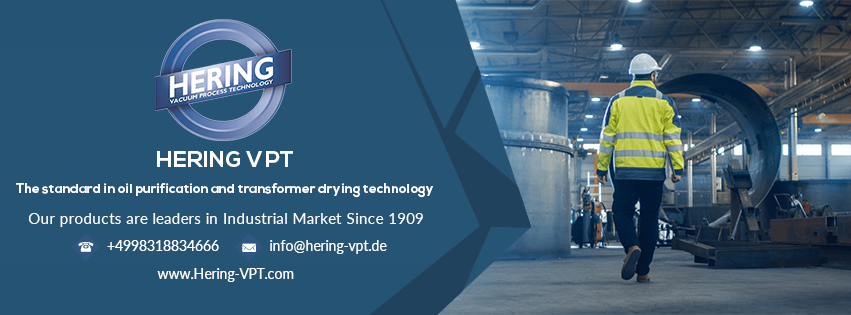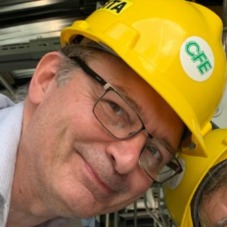
Transformer oil Regeneration/Reclamation is a key process in Transformer waste management and sustainability. It is the process of removing water and other oxidation by-products from the insulating oil. Transformer oil regeneration is performed on-site, either while the oil is still in the power transformer (on-load), or in barrels or tanks (off-load).
The process of regeneration/reclamation includes the following:
– Physical-Chemical Regeneration and Dehydration of Transformer Insulating Oil
– Restoration of all physical, chemical and electrical oil characteristics
Guaranteed oil characteristics after regeneration:
Used oils are regenerated to the level of new-unused ones in accordance with the specifications for the new oils under IEC 60296 (including oxidation stability). Hering-VPT are veterans in this field and have been dealing with Transformer oil reclamation for decades by assisting our clients, who mainly comprise international power utility providers, transformer manufacturers, and transformer service companies.
TRANSFORMER OIL REGENERATION PROCESS
The primary functions of the insulating fluid are to serve as a dielectric material and an effective coolant. In order to carry out the necessary workflows, the dielectric fluid must possess the desirable characteristic properties during the initial impregnation time period and filling, at the factory premises. These ideal properties must be maintained at the same high-quality level even during field operation in order to guarantee optimum performance. Transformer oil quality gradually deteriorates over time. This is due to the high operating temperatures that the equipment is subject to, causing the catalytic reaction of contaminants like oxygen and moisture with the materials, which result in oxidation and the cracking of oil.
The end products of the oxidation reaction are acidic in nature. The long-term impact of these by-products are a rapid deterioration of the Transformer and Transformer oil properties. It causes a residual sludge build up which drastically reduces the cooling properties of the oil by perpetuating the entire decay process at an exponentially accelerated pace. The level of acidity reaches exponential levels up to 0.25 mg KOH/g oil level. The oil acidity levels must never go this high and precautionary measures must be taken to ensure the same. Generally, a larger transformer plate rating corresponds to a lower acidity level that triggers regeneration of the oil. In traditional processes, Fullers earth was generally used to lower the acidity level on a one-time batch basis and then safely disposed of.
How Hering VPT can help you with Transformer Oil Regeneration and Reclamation
Hering-VPT, EOK-TORS, Transformer Oil Regeneration System provides an extremely cost-effective and environmentally acceptable method of extending transformer oil lifetime to over 50+ years! Used oil is strained, heated and filtered prior to flowing into a bank of columns which are filled with our special HERING PHÖNIX, an adsorbent regeneration media. The oil’s primary physical parameters are restored during this phase. Once it exits from the column, the oil is then passed through a degasification unit, a filter that restores the oils essential properties to almost new conditions. The banks of columns gradually begin to get saturated and reactivation is required. Typically, reactivation is performed inside columns, thus, the adsorbent material need not be removed. While the reactivation process happens in the first column, a second bank of columns is used to regenerate the oil.
Hering-VPT’s double bank system allows for 24-hour processing without having to shut down. Once reactivated, the bank is again ready for processing. On average, between 300 and 500 reactivations per bank ensure that the media only needs to be changed once in a few years. Once exhausted, the media is reactivated one final time and is then discarded as a dry waste in a normal landfill – it is completely devoid of any oily waste. The regeneration plants are ideally suited for processing transformers that are either energized or off-load and tank farm applications too.
During this process, the oil used in transformer has to be monitored thoroughly for various parameters. The upper and lower limit for these parameters has grown more accurate and stringent over time. If these controlled parameters are breached, immediate responsive maintenance action must be taken. In modern Transformer oil Filtration, the key differentiating factor is that a lesser quantity of adsorbent materials is used for Transformer moisture removal and maintaining dielectric strength of transformer oil, as compared to traditional oil filtration systems. With Hering VPT equipment, the used oil recycling process takes place in two modes: A Treatment mode and A Reactivation mode.
Treatment mode in used oil recycling
During Treatment mode, the used oil is taken from the bottom part of the tank and then heated to remove moisture and restore dielectric strength of the Transformer oil. It is then filtered by passing through the absorbent material, the signature Hering Phonix clay. After being passed through the columns of the adsorbent material, it goes through a filter, followed by a degasser which even further removes any moisture and other contaminants. Finally, it reaches the expansion vessel from where it returns to be used within a transformer. The treatment mode is active until the adsorbent properties of our PHONIX clay deteriorates.
Reactivation mode in used oil recycling
In this mode, the used oil is directly sent to the filter degasser after bypassing the adsorbent columns. This lowers the moisture content and level of other contaminants even further. After being reactivated and used multiple times, it is common to wonder about the oxidation stability of reactivated used oils as compared to new oils. However, after intense research by the Hering VPT R&D team, data suggest that even after 3 years, the defining characteristics of used oil after reactivation is almost similar to that of new oils. The quality can be even better by combining with the process of re-inhibiting transformer oil. The acidity and moisture levels are monitored and compared after every reactivation cycle. They are also compared with re-inhibitor cycles. This data helps Hering VPT find the optimum reactivation process that suits your needs.
Hering VPT equipment comes with an assurance of quality. Our state-of-the-art German technology is built to give our clients the most efficient outputs from their waste oil refinery plants. Even from an environmental point of view, our equipment was built by taking into initial consideration the need for waste oil management and easy disposable into approved landfills nearby. The by-products after Waste oil regeneration from Hering VPT equipment are not toxic in nature and are instantly ready for safe disposal. At Hering VPT, our happy clients who also consist of used oil recycling plant manufacturers, place their trust in us and rest easy. We train their staff so that they are equipped with up to date knowledge and transformer oil filtration are able to deal with any situations that may arise.
References:
Berg, Ø. I. S. T. E. I. N., Herdlevar, K. N. U. T., Dahlund, M. A. T. S., Renström, K. J. E. L. L., Danielsen, A. N. D. R. E. A. S., & Thiess, U. (2002). Experiences from on-site transformer oil reclaiming. CIGRÉ Main session, 12-103
Lv, Y. Z., Zhou, Y., Li, C. R., Wang, Q., & Qi, B. (2014). Recent progress in nanofluids based on transformer oil: preparation and electrical insulation properties. IEEE Electrical Insulation Magazine, 30(5), 23-32.
Mauntz, M., Kuipers, U., & Peuser, J. (2014, July). Renewable energy power grid protection by continuous online condition monitoring of oil aging in high voltage transformers and oil regeneration systems. In the Eighth International Conference on Material and Modeling MMT-2014 (pp. 86-94).


